Impacts of Low-Carbon Policies on Air Quality in China’s Metropolitan Areas: Evidence from a Difference-in-Differences Study
Abstract
1. Introduction
2. Low-Carbon Policies on Air Quality in China’s Metropolitan Areas
2.1. The Impact of Low-Carbon Actions on Air Quality
2.2. Low-Carbon City Pilot Policy in China
3. Methodology
3.1. Data
3.2. Benchmarking Estimation
3.2.1. Difference-in-Differences with Two-Way Fixed Effects (TWFE-DID)
3.2.2. Event Study
3.2.3. Variable Descriptions
3.3. Heterogeneity Treatment Effect Test
3.3.1. DID Decomposition Estimates
3.3.2. DID Estimation Based on Nonparametric Identification
3.3.3. DID Estimation Based on Imputation
4. Results
4.1. Benchmarking Impacts
4.1.1. Results of the TWFE-DID Estimation
4.1.2. The Dynamic Effects
4.1.3. Results of Placebo Test
4.2. Results of Heterogeneity Treatment Effects Estimation
4.2.1. DID Decomposition Result
4.2.2. Heterogeneity-Robust Estimates
4.2.3. Effects of Different LCCP Batches on AQI
4.3. Mechanism Testing and Heterogeneity Analysis
4.3.1. Mechanism Testing
4.3.2. Heterogeneity Analysis
5. Conclusions and Discussions
Author Contributions
Funding
Institutional Review Board Statement
Informed Consent Statement
Data Availability Statement
Acknowledgments
Conflicts of Interest
References
- De Jong, M.; Joss, S.; Schraven, D.; Zhan, C.; Weijnen, M. Sustainable–smart–resilient–low carbon–eco–knowledge cities: Making sense of a multitude of concepts promoting sustainable urbanization. J. Clean. Prod. 2015, 109, 25–38. [Google Scholar] [CrossRef]
- Shan, W.; Chen, S.; Wang, G.; Li, J.; Bo, X. Clearing the Air: Assessing the Effectiveness of Emission Policy in Qinhuangdao’s Key Industries. Atmosphere 2023, 14, 1218. [Google Scholar] [CrossRef]
- Kamińska, J.A.; Turek, T.; Van Poppel, M.; Peters, J.; Hofman, J.; Kazak, J.K. Whether cycling around the city is in fact healthy in the light of air quality: Results of black carbon. J. Environ. Manag. 2023, 337, 117694. [Google Scholar] [CrossRef] [PubMed]
- Shu, Y.; Hu, J.; Zhang, S.; Schöpp, W.; Tang, W.; Du, J.; Cofala, J.; Kiesewetter, G.; Sander, R.; Winiwarter, W.; et al. Analysis of the air pollution reduction and climate change mitigation effects of the Three-Year Action Plan for Blue Skies on the “2 + 26” Cities in China. J. Environ. Manag. 2022, 317, 115455. [Google Scholar] [CrossRef]
- Zhong, J.; Hodgson, J.R.; Bloss, W.J.; Shi, Z. Impacts of net zero policies on air quality in a metropolitan area of the United Kingdom: Towards world health organization air quality guidelines. Environ. Res. 2023, 236, 116704. [Google Scholar] [CrossRef]
- Yang, S.; Jahanger, A.; Hossain, M.R. How effective has the low-carbon city pilot policy been as an environmental intervention in curbing pollution? Evidence from Chinese industrial enterprises. Energy Econ. 2023, 118, 106523. [Google Scholar] [CrossRef]
- Weko, S.; Goldthau, A. Bridging the low-carbon technology gap? Assessing energy initiatives for the Global South. Energy Policy 2022, 169, 113192. [Google Scholar] [CrossRef]
- Hosein, A.S.; Whale, J.; Simsek, Y.; Urmee, T. Exploring energy policy scenarios to transition to a low carbon economy by 2050: A case study on the Northern Territory of Australia. Energy Policy 2023, 180, 113663. [Google Scholar] [CrossRef]
- Räihä, J.; Clarke, S.; Sankelo, P.; Ruokamo, E.; Kangas, H.L. The importance of organization type: Construction sector perceptions of low-carbon policies and measures. Environ. Sci. Policy 2024, 151, 103602. [Google Scholar] [CrossRef]
- The Royal Society. Effects of Net-Zero Policies and Climate Change on Air Quality. 2021. Available online: https://royalsociety.org/-/media/policy/projects/air-quality/air-quality-and-climate-change-report.pdf (accessed on 12 April 2024).
- Wei, X.; Tong, Q.; Magill, I.; Vithayasrichareon, P.; Betz, R. Evaluation of potential co-benefits of air pollution control and climate mitigation policies for China’s electricity sector. Energy Econ. 2020, 92, 104917. [Google Scholar] [CrossRef]
- Li, X.; Xing, H. Better cities better lives: How low-carbon city pilots can lower residents’ carbon emissions. J. Environ. Manag. 2024, 351, 119889. [Google Scholar] [CrossRef] [PubMed]
- Office of the Leading Group of the State Council for the Seventh National Population Census. China Population Census Yearbook 2020; China Statistics Press: Beijing, China, 2020.
- Zhang, J.; Gao, L.; Wang, W.; Deng, Z.; Zhang, X. The impact of low-carbon city pilot policies on air quality: Quasi-natural experimental evidence from China. Atmosphere 2022, 13, 1355. [Google Scholar] [CrossRef]
- Lyu, J.; Liu, T.; Cai, B.; Qi, Y.; Zhang, X. Heterogeneous effects of China’s low-carbon city pilots policy. J. Environ. Manag. 2023, 344, 118329. [Google Scholar] [CrossRef]
- Chen, J.; Luo, W.; Ren, X.; Liu, T. The local-neighborhood effects of low-carbon city pilots program on PM2.5 in China: A spatial difference-in-differencess analysis. Sci. Total Environ. 2023, 857, 159511. [Google Scholar] [CrossRef] [PubMed]
- Zhao, S.; Zhang, L.; An, H.; Peng, L.; Zhou, H.; Hu, F. Has China’s low-carbon strategy pushed forward the digital transformation of manufacturing enterprises? Evidence from the low-carbon city pilot policy. Environ. Impact Assess. Rev. 2023, 102, 107184. [Google Scholar] [CrossRef]
- Odman, M.T.; Hu, Y.; Russell, A.G.; Hanedar, A.; Boylan, J.W.; Brewer, P.F. Quantifying the sources of ozone, fine particulate matter, and regional haze in the Southeastern United States. J. Environ. Manag. 2009, 90, 3155–3168. [Google Scholar] [CrossRef]
- Wang, Y.; Song, Q.; He, J.; Qi, Y. Developing low-carbon cities through pilots. Clim. Policy 2015, 15, S81–S103. [Google Scholar] [CrossRef]
- Teets, J.C.; Hasmath, R. The evolution of policy experimentation in China. J. Asian Public Policy 2020, 13, 49–59. [Google Scholar] [CrossRef]
- Song, Q.; Liu, T.; Qi, Y. Policy innovation in low carbon pilot cities: Lessons learned from China. Urban Clim. 2021, 39, 100936. [Google Scholar] [CrossRef]
- Tsai, W.H.; Dean, N. Experimentation under hierarchy in local conditions: Cases of political reform in Guangdong and Sichuan, China. China Q. 2014, 218, 339–358. [Google Scholar] [CrossRef]
- Luo, X.; Lin, G.; Wan, Q.; Jin, G. Inspiration or perspiration: Diffusion of China’s low-carbon city pilot policies nationwide. J. Clean. Prod. 2023, 428, 139291. [Google Scholar] [CrossRef]
- National Development and Reform Commission of China (NDRC). Notice on Carrying out Pilot Projects in Low-Carbon Provinces and Low-Carbon Cities. (NDRC Climate [2010] No. 1587). 2010. Available online: https://www.ndrc.gov.cn/xxgk/zcfb/tz/201008/t20100810_964674.html (accessed on 18 February 2024).
- National Development and Reform Commission of China (NDRC). Notice on Carrying out the Second Batch of National Low-Carbon Provinces and Low-Carbon City Pilot Projects. (NDRC Climate [2012] No. 3760). 2012. Available online: https://www.ccchina.org.cn/Detail.aspx?newsId=73289&TId=285 (accessed on 18 February 2024).
- National Development and Reform Commission of China (NDRC). Notice on Carrying out the Third Batch of National Low-Carbon City Pilot Projects. (NDRC Climate [2017] No. 66). 2017. Available online: https://www.gov.cn/xinwen/2017-01/24/content_5162933.htm (accessed on 18 February 2024).
- Wu, Q.; Sun, Z.; Jiang, L.; Jiang, L. “Bottom-up” abatement on climate from the “top-down” design: Lessons learned from China’s low-carbon city pilot policy. Empir. Econ. 2024, 66, 1223–1257. [Google Scholar] [CrossRef]
- Zhao, S.; Shi, A.; An, H.; Zhou, H.; Hu, F. Does the low-carbon city pilot contribute to the blue sky defense? Evidence from China. Environ. Sci. Pollut. Res. 2023, 30, 84595–84608. [Google Scholar] [CrossRef]
- Ministry of Ecology and Environment of the People’s Republic of China. National Low-Carbon City Pilot Progress Evaluation Report. 2023. Available online: https://www.mee.gov.cn/ywgz/ydqhbh/wsqtkz/202307/W020230713602785966247.pdf (accessed on 18 February 2024).
- Mewes, C.; Unger, C. Learning by doing: Co-benefits drive national plans for climate and air quality governance. Atmosphere 2021, 12, 1184. [Google Scholar] [CrossRef]
- Ministry of Environmental Protection of the People’s Republic of China; General Administration of Quality Supervision; Inspection and Quarantine of the People’s Republic of China. Ambient Air Quality Standards/GB3095-2012; China Environmental Sciences Press: Beijing, China, 2012.
- Yu, Y.; Zhang, N. Low-carbon city pilot and carbon emission efficiency: Quasi-experimental evidence from China. Energy Econ. 2021, 96, 105125. [Google Scholar] [CrossRef]
- Beck, T.; Levine, R.; Levkov, A. Big bad banks? The winners and losers from bank deregulation in the United States. J. Financ. 2010, 65, 1637–1667. [Google Scholar] [CrossRef]
- Jacobson, L.S.; LaLonde, R.J.; Sullivan, D.G. Earnings losses of displaced workers. Am. Econ. Rev. 1993, 83, 685–709. [Google Scholar] [CrossRef]
- De Chaisemartin, C.; d’Haultfoeuille, X. Two-way fixed effects estimators with heterogeneous treatment effects. Am. Econ. Rev. 2020, 110, 2964–2996. [Google Scholar] [CrossRef]
- Borusyak, K.; Jaravel, X.; Spiess, J. Revisiting event study designs: Robust and efficient estimation. Rev. Econ. Stud. 2024, 91, 3253–3285. [Google Scholar] [CrossRef]
- Goodman-Bacon, A. Difference-in-differencess with variation in treatment timing. J. Econom. 2021, 225, 254–277. [Google Scholar] [CrossRef]
- Callaway, B.; Sant’Anna, P.H. Difference-in-differences with multiple time periods. J. Econom. 2021, 225, 200–230. [Google Scholar] [CrossRef]
- Sant’Anna, P.H.; Zhao, J. Doubly robust difference-in-differencess estimators. J. Econom. 2020, 219, 101–122. [Google Scholar] [CrossRef]
- Roth, J. Pretest with caution: Event-study estimates after testing for parallel trends. Am. Econ. Rev. Insights 2022, 4, 305–322. [Google Scholar] [CrossRef]
- Chen, Q.; Qi, J.; Yan, G. DIDPLACEBO: Stata Module for In-Time, In-Space and Mixed Placebo Tests for Estimating Difference-in-Differencess (DID) Models. EconPapers. 2023. Available online: https://econpapers.repec.org/software/bocbocode/s459225.htm (accessed on 1 March 2025).
- Sun, L.; Abraham, S. Estimating dynamic treatment effects in event studies with heterogeneous treatment effects. J. Econom. 2021, 225, 175–199. [Google Scholar] [CrossRef]
- Guo, S.; Song, Q.; Qi, Y. Innovation or implementation? Local response to low-carbon policy experimentation in China. Rev. Policy Res. 2021, 38, 555–569. [Google Scholar] [CrossRef]
- Kostka, G.; Nahm, J. Central–local relations: Recentralization and environmental governance in China. China Q. 2017, 231, 567–582. [Google Scholar] [CrossRef]
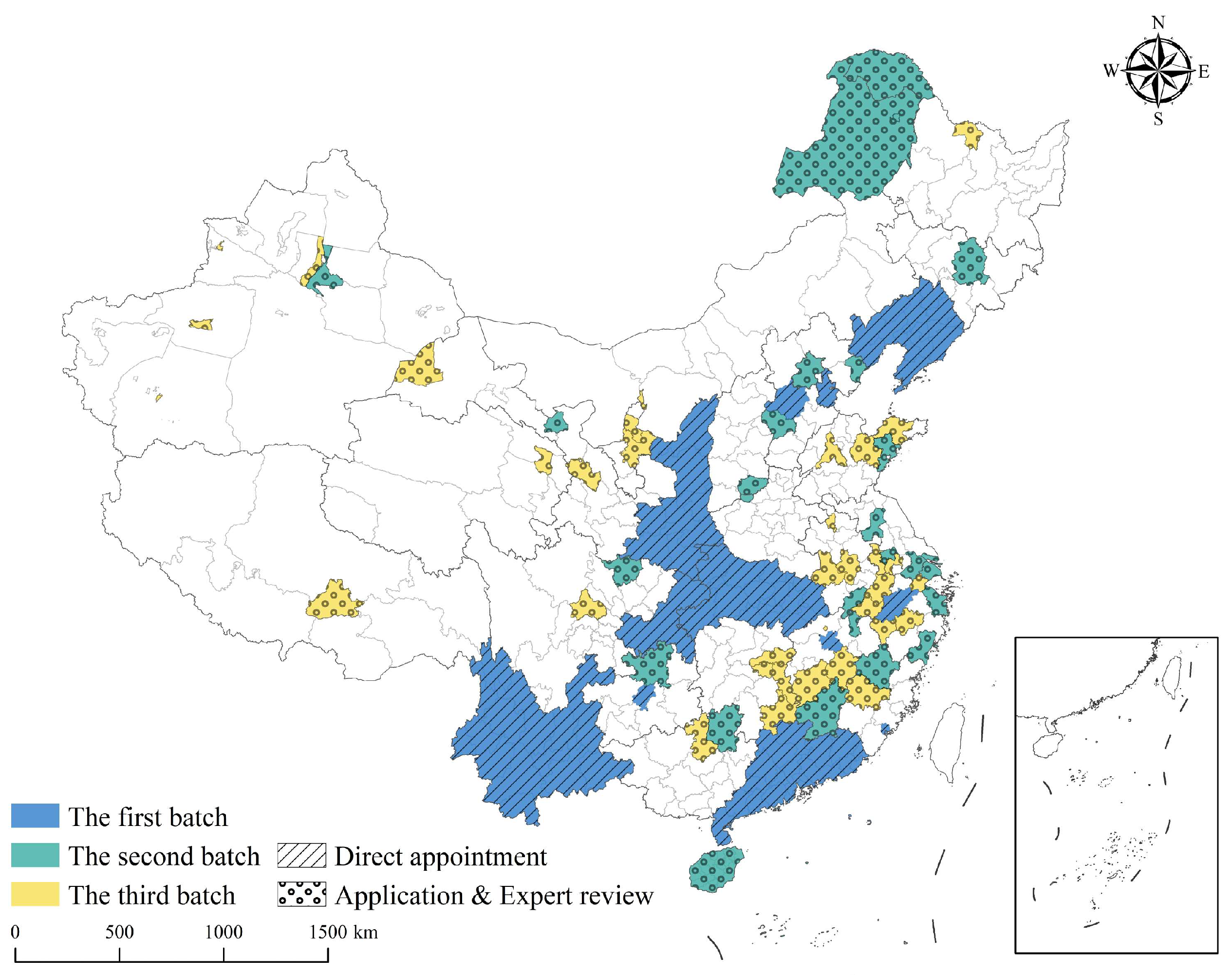
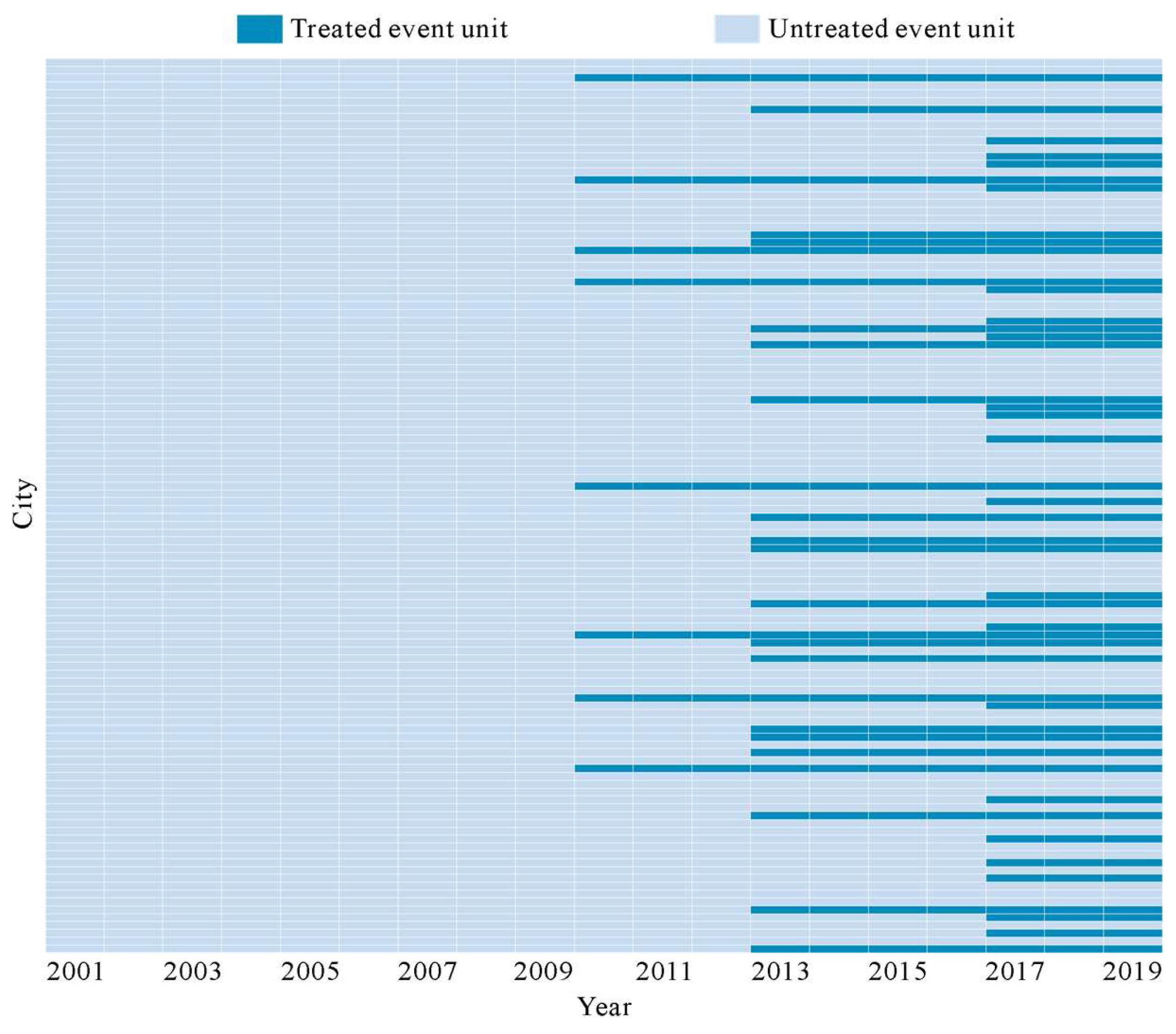
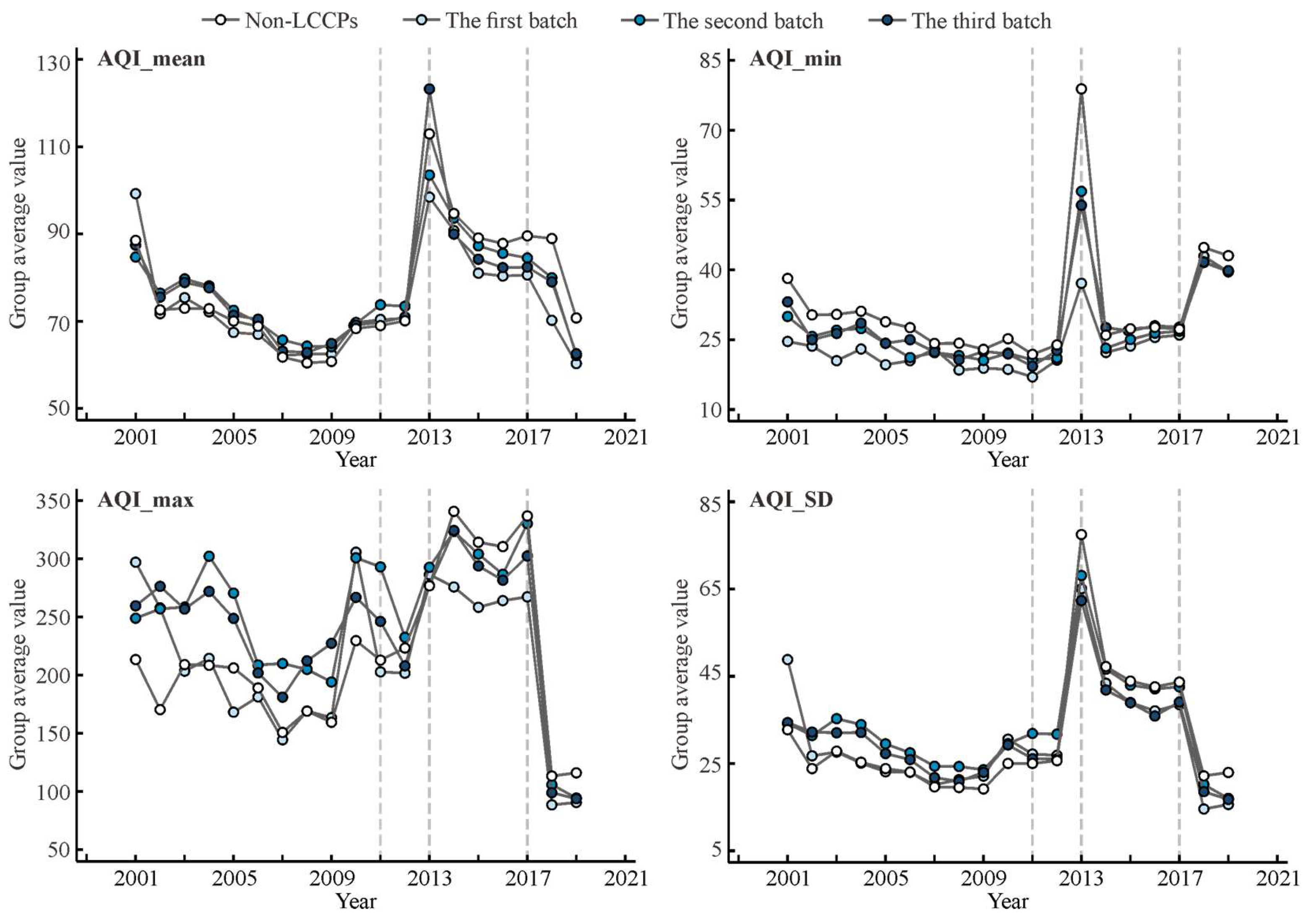
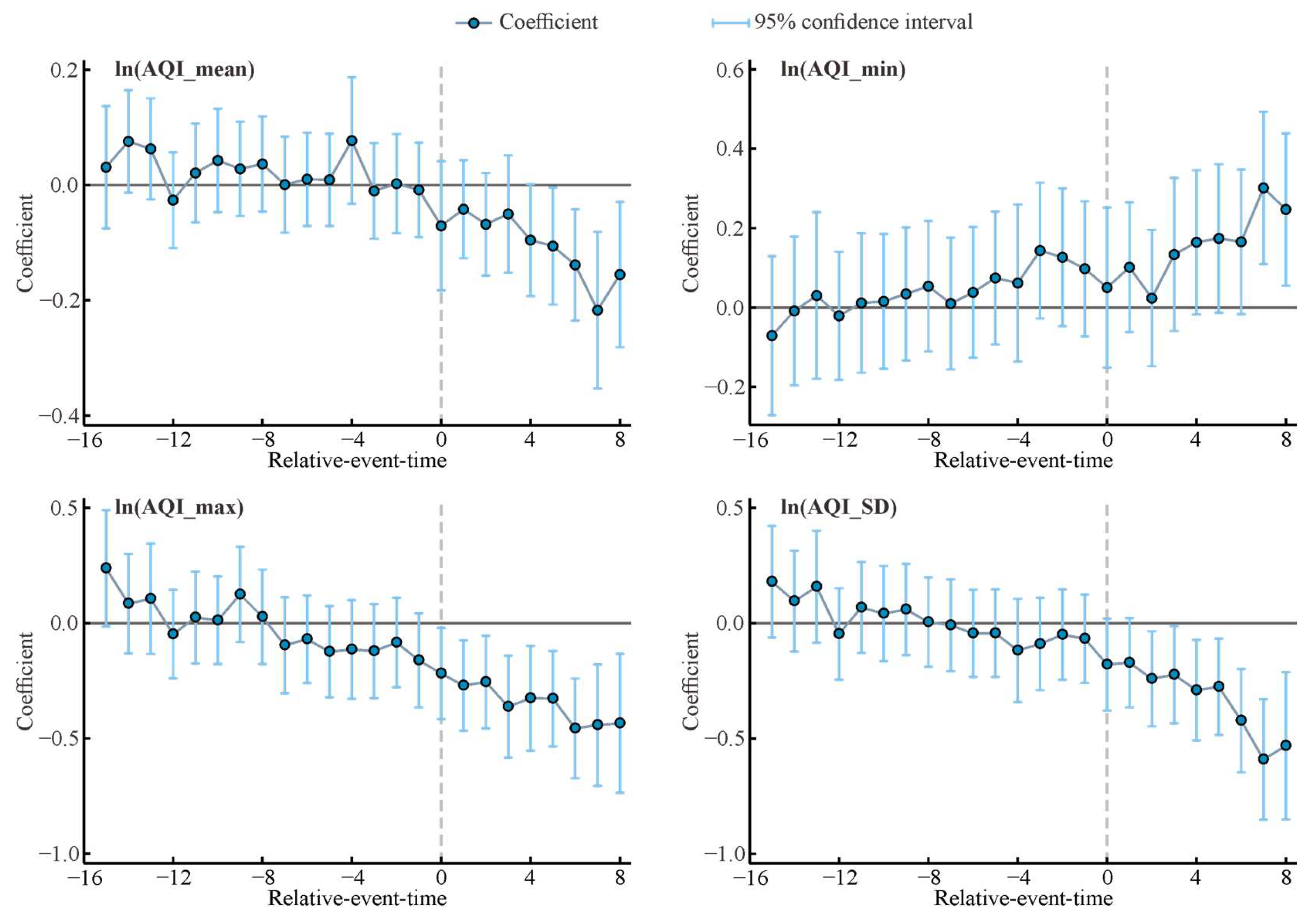
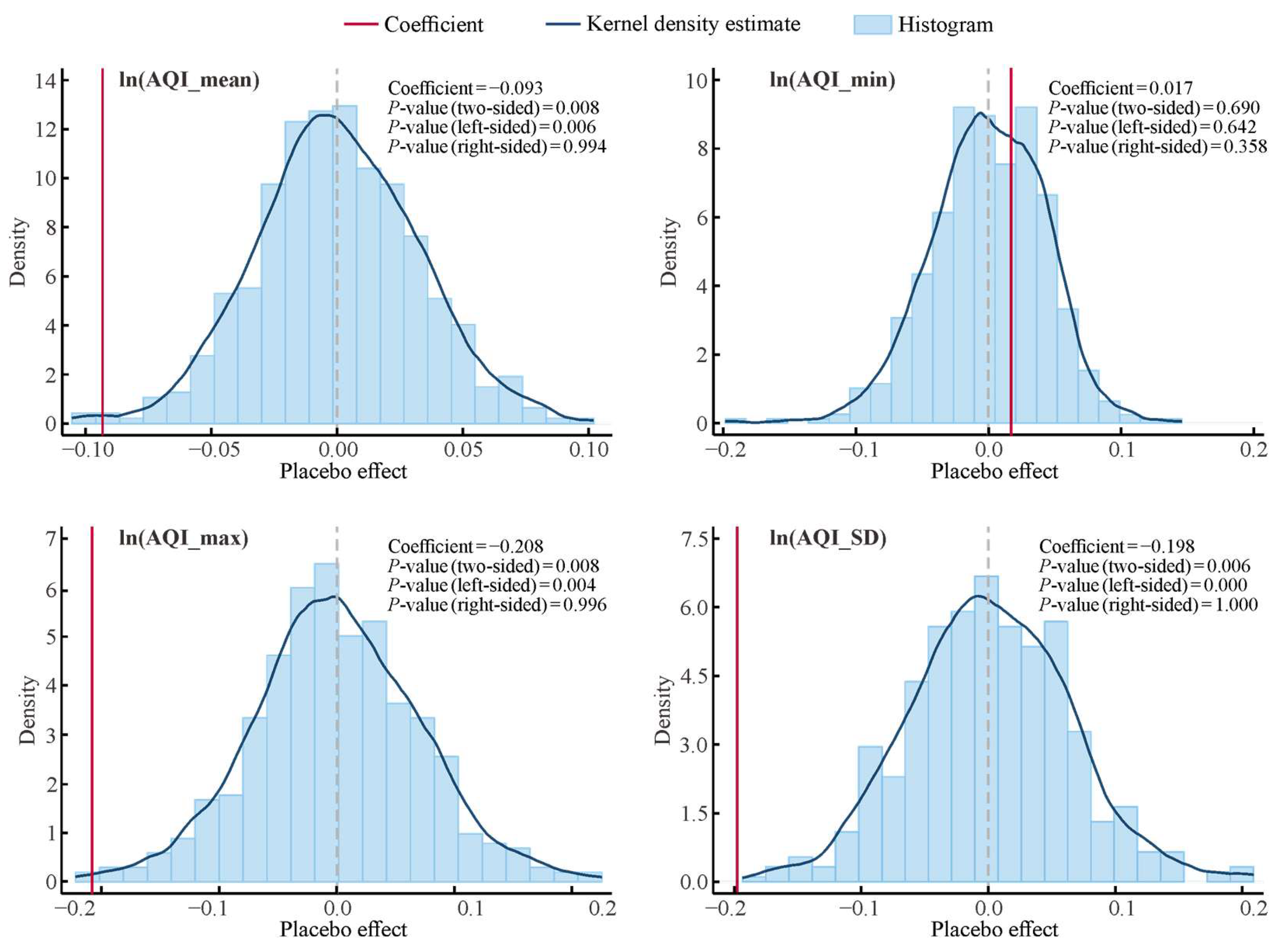

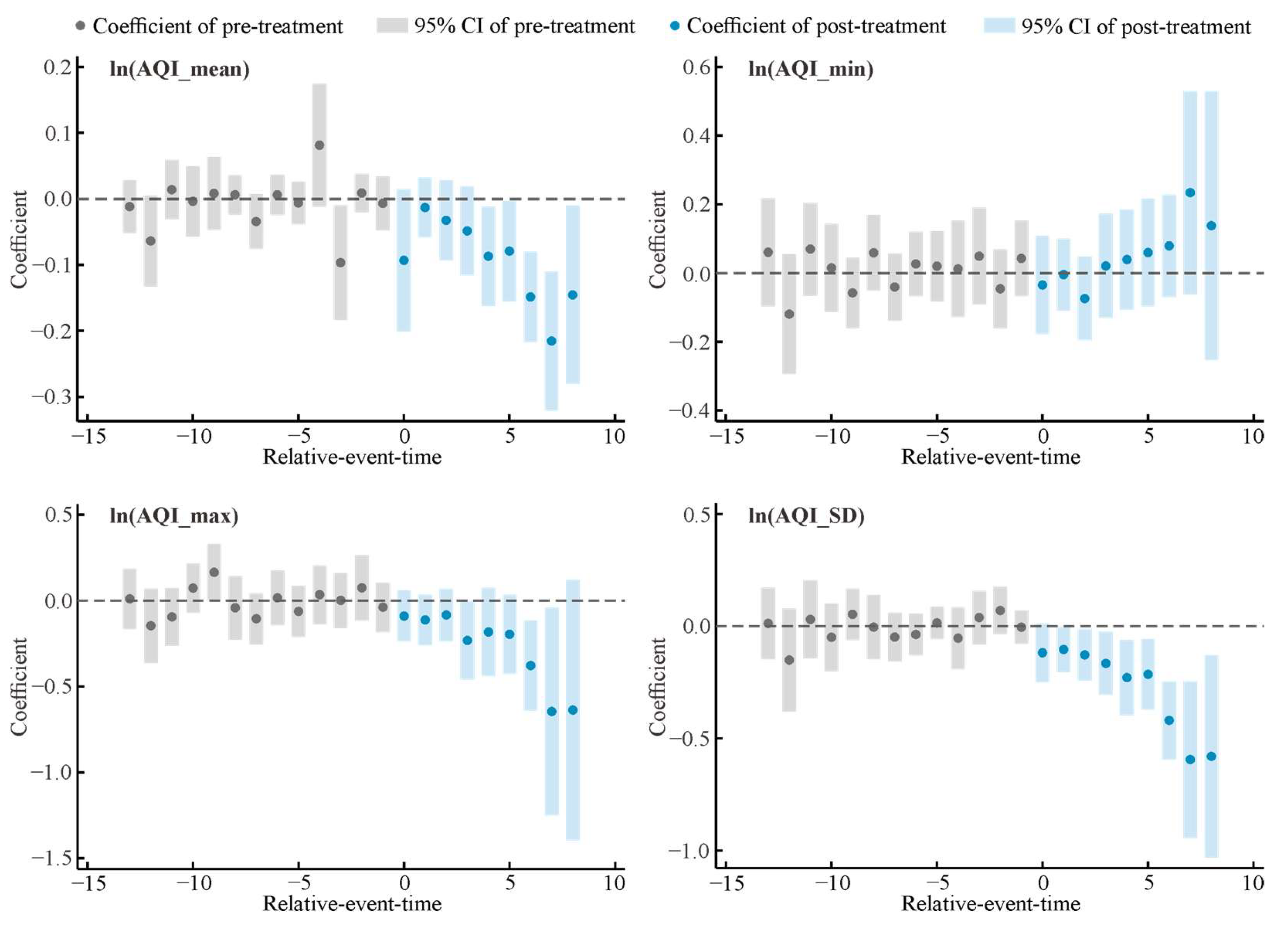
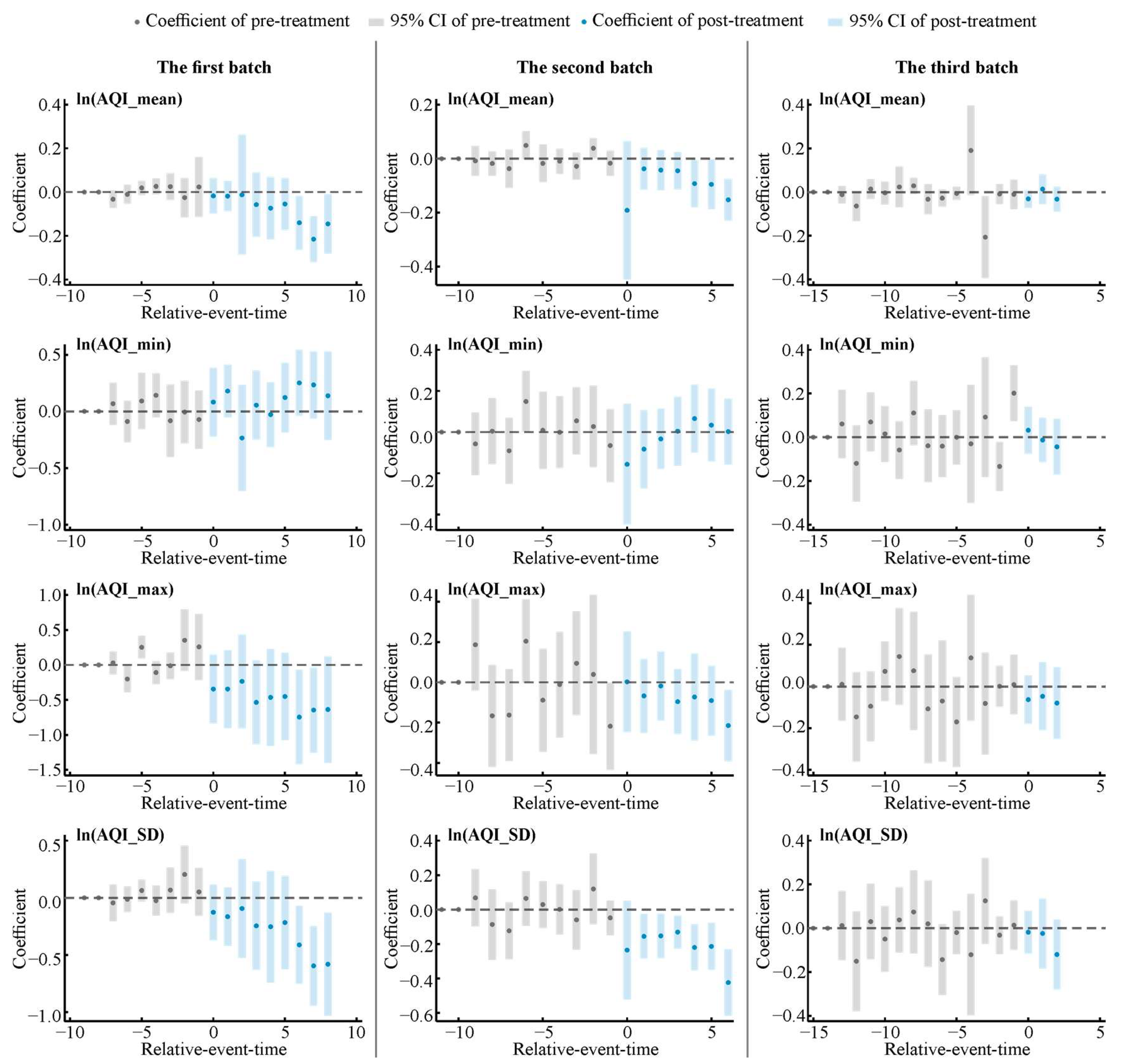
| Variable Name | Variable Definition | Obs. | Mean | Min. | Max. | SD |
|---|---|---|---|---|---|---|
| Dependent variable | ||||||
| AQI_mean | Mean of AQI | 2166 | 77.109 | 18.070 | 346.667 | 24.547 |
| AQI_min | Minimum of AQI | 2158 | 30.000 | 6.000 | 240.000 | 17.788 |
| AQI_max | Maximum of AQI | 2166 | 226.313 | 28.000 | 500.000 | 135.330 |
| AQI_SD | Standard deviation of AQI | 1241 | 30.840 | 3.576 | 162.819 | 18.782 |
| Treatment variable | ||||||
| Policy | Treatment status | 2166 | 0.119 | 0 | 1 | 0.324 |
| Control variable | ||||||
| Sec_ind (%) | Secondary industry rate | 2158 | 48.398 | 7.430 | 84.400 | 12.699 |
| Urbanization (%) | Urbanization rate | 1932 | 56.878 | 14.990 | 100.000 | 17.488 |
| Green cover (%) | Green coverage rate | 2119 | 38.490 | 1.060 | 92.870 | 7.315 |
| Variable | ln(AQI_Mean) | ln(AQI_Min) | ln(AQI_Max) | ln(AQI_SD) | ||||
|---|---|---|---|---|---|---|---|---|
| Model 1 | Model 2 | Model 3 | Model 4 | Model 5 | Model 6 | Model 7 | Model 8 | |
| Policy | −0.091 *** (0.016) | −0.093 *** (0.016) | 0.035 (0.026) | 0.017 (0.027) | −0.230 *** (0.032) | −0.208 *** (0.033) | −0.209 *** (0.028) | −0.198 *** (0.028) |
| Sec_ind | 0.003 *** (0.001) | −0.003 * (0.001) | 0.007 *** (0.002) | 0.006 *** (0.001) | ||||
| Urbanization | 0.002 *** (0.001) | −0.000 (0.001) | 0.004 *** (0.002) | 0.003 ** (0.001) | ||||
| Green cover | −0.002 *** (0.001) | −0.001 (0.001) | −0.005 *** (0.002) | −0.005 *** (0.002) | ||||
| Constant | 4.312 *** (0.004) | 4.161 *** (0.049) | 3.282 *** (0.007) | 3.445 *** (0.106) | 5.272 *** (0.009) | 4.890 *** (0.129) | 3.304 *** (0.007) | 3.040 *** (0.102) |
| Obs. | 2166 | 1894 | 2158 | 1886 | 2166 | 1894 | 2141 | 1869 |
| R-squared | 0.743 | 0.747 | 0.641 | 0.655 | 0.657 | 0.669 | 0.708 | 0.728 |
| Control variable | No | Yes | No | Yes | No | Yes | No | Yes |
| Item | ln(AQI_Mean) | ln(AQI_Min) | ln(AQI_Max) | ln(AQI_SD) | ||||
|---|---|---|---|---|---|---|---|---|
| CS-DID | IP-DID | CS-DID | IP-DID | CS-DID | IP-DID | CS-DID | IP-DID | |
| ATT | −0.074 *** (0.025) | −0.097 *** (0.034) | 0.013 (0.055) | 0.028 (0.041) | −0.193 * (0.101) | −0.217 *** (0.072) | −0.205 *** (0.062) | −0.207 *** (0.064) |
| Obs. | 1881 | 1894 | 1872 | 1886 | 1881 | 1894 | 1856 | 1894 |
| Control variable | Yes | Yes | Yes | Yes | Yes | Yes | Yes | Yes |
| ln(AQI_Mean) | ln(AQI_Min) | ln(AQI_Max) | ln(AQI_SD) | |
|---|---|---|---|---|
| The first batch | −0.081 * (0.044) | 0.093 (0.134) | −0.490 (0.305) | −0.294 * (0.174) |
| The second batch | −0.091 ** (0.041) | −0.023 (0.071) | −0.082 (0.074) | −0.221 *** (0.057) |
| The third batch | −0.016 (0.019) | −0.008 (0.050) | −0.063 (0.065) | −0.054 (0.059) |
| Batch average | −0.061 *** (0.021) | 0.004 (0.044) | −0.147 ** (0.068) | −0.165 *** (0.048) |
| Obs. | 1881 | 1872 | 1881 | 1856 |
| Factor | Coefficient | S.E. |
|---|---|---|
| Expenditure on science and technology (×109 RMB) | 2.833 *** | 0.334 |
| The secondary industry rate (%) | −1.374 *** | 0.477 |
| Number of buses (×108 buses) | 0.078 *** | 0.023 |
| Green coverage rate (%) | 0.009 | 0.504 |
| Indicator | Group | ln(AQI_Mean) | ln(AQI_Min) | ln(AQI_Max) | ln(AQI_SD) |
|---|---|---|---|---|---|
| AQI | Low | −0.027 (0.029) | 0.005 (0.051) | −0.099 * (0.052) | −0.071 (0.046) |
| Medium | −0.132 *** (0.021) | −0.087 * (0.047) | −0.222 *** (0.063) | −0.227 *** (0.047) | |
| High | −0.107 *** (0.033) | 0.129 *** (0.043) | −0.295 *** (0.062) | −0.235 *** (0.552) | |
| Secondary industry rate (%) | Low | −0.078 ** (0.033) | −0.018 (0.052) | −0.110 * (0.058) | −0.165 *** (0.053) |
| Medium | −0.078 *** (0.025) | 0.069 * (0.040) | −0.231 *** (0.054) | −0.170 *** (0.043) | |
| High | −0.116 *** (0.023) | 0.022 (0.048) | −0.238 *** (0.068) | −0.299 *** (0.053) | |
| Urbanization rate (%) | Low | −0.044 (0.057) | −0.054 (0.083) | 0.105 (0.082) | −0.065 (0.086) |
| Medium | −0.053 ** (0.025) | 0.034 (0.042) | −0.053 (0.054) | −0.032 (0.412) | |
| High | −0.096 *** (0.023) | 0.010 (0.041) | −0.331 *** (0.050) | −0.234 **** (0.044) | |
| Green coverage rate (%) | Low | −0.165 *** (0.029) | −0.079 (0.048) | −0.142 ** (0.063) | −0.235 *** (0.055) |
| Medium | −0.028 (0.023) | 0.062 (0.038) | −0.130 ** (0.053) | −0.078 * (0.042) | |
| High | −0.084 *** (0.032) | 0.067 (0.059) | −0.316 *** (0.062) | −0.270 *** (0.048) | |
| Total CO2 emissions (megaton) | Low | −0.067 * (0.037) | 0.011 (0.070) | −0.077 (0.082) | −0.158 ** (0.074) |
| Medium | −0.112 *** (0.027) | 0.036 (0.048) | −0.139 ** (0.056) | −0.227 *** (0.047) | |
| High | −0.117 *** (0.026) | −0.017 (0.040) | −0.311 *** (0.059) | −0.204 *** (0.048) | |
| GDP (×109 RMB) | Low | −0.100 *** (0.035) | −0.095 (0.060) | 0.041 (0.091) | −0.084 (0.077) |
| Medium | −0.085 *** (0.032) | 0.124 ** (0.050) | −0.199 *** (0.057) | −0.279 *** (0.051) | |
| High | −0.112 *** (0.024) | −0.035 (0.041) | −0.290 *** (0.054) | −0.217 *** (0.044) | |
| Area | Eastern areas | −0.230 *** (0.058) | −0.063 (0.079) | −0.342 *** (0.102) | −0.436 *** (0.098) |
| Middle areas | −0.171 *** (0.050) | −0.046 (0.068) | −0.293 *** (0.085) | −0.310 *** (0.074) | |
| Western areas | −0.071 *** (0.018) | 0.041 (0.032) | −0.192 *** (0.040) | −0.170 *** (0.031) |
Disclaimer/Publisher’s Note: The statements, opinions and data contained in all publications are solely those of the individual author(s) and contributor(s) and not of MDPI and/or the editor(s). MDPI and/or the editor(s) disclaim responsibility for any injury to people or property resulting from any ideas, methods, instructions or products referred to in the content. |
© 2025 by the authors. Licensee MDPI, Basel, Switzerland. This article is an open access article distributed under the terms and conditions of the Creative Commons Attribution (CC BY) license (https://creativecommons.org/licenses/by/4.0/).
Share and Cite
Niu, X.; Liu, Y. Impacts of Low-Carbon Policies on Air Quality in China’s Metropolitan Areas: Evidence from a Difference-in-Differences Study. Atmosphere 2025, 16, 339. https://doi.org/10.3390/atmos16030339
Niu X, Liu Y. Impacts of Low-Carbon Policies on Air Quality in China’s Metropolitan Areas: Evidence from a Difference-in-Differences Study. Atmosphere. 2025; 16(3):339. https://doi.org/10.3390/atmos16030339
Chicago/Turabian StyleNiu, Xuejiao, and Ying Liu. 2025. "Impacts of Low-Carbon Policies on Air Quality in China’s Metropolitan Areas: Evidence from a Difference-in-Differences Study" Atmosphere 16, no. 3: 339. https://doi.org/10.3390/atmos16030339
APA StyleNiu, X., & Liu, Y. (2025). Impacts of Low-Carbon Policies on Air Quality in China’s Metropolitan Areas: Evidence from a Difference-in-Differences Study. Atmosphere, 16(3), 339. https://doi.org/10.3390/atmos16030339









